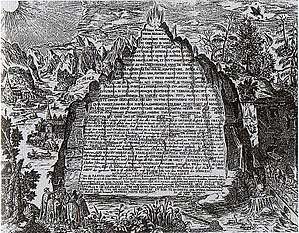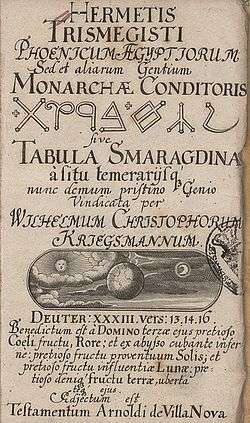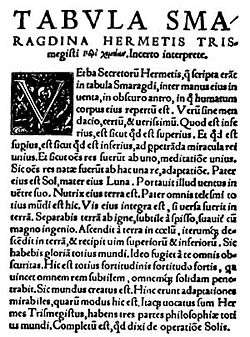Emerald Tablet

The Emerald Tablet, also known as the Smaragdine Table, or Tabula Smaragdina, is a compact and cryptic piece of the Hermetica reputed to contain the secret of the prima materia and its transmutation. It was highly regarded by European alchemists as the foundation of their art and its Hermetic tradition. The original source of the Emerald Tablet is unknown. Although Hermes Trismegistus is the author named in the text, its first known appearance is in a book written in Arabic between the sixth and eighth centuries. The text was first translated into Latin in the twelfth century. Numerous translations, interpretations and commentaries followed.
The layers of meaning in the Emerald Tablet have been associated with the creation of the philosopher's stone(THE LINK), laboratory experimentation, phase transition, the alchemical magnum opus, mystical psychosis, cosmic consciousness, unus mundus, anima mundi, The All (of Hermetism/Hermeticism), successful child conception out of proved pure love, the ancient, classical, element system, and the correspondence between macrocosm and microcosm.
Similarities and correspondences with the Emerald Tablet have been drawn with Eastern philosophies like Daoism (Tao Te Ching, Tao, wuji, YinYang, and the I Ching), Hinduism, and Buddhism, and even with the Book of Genesis and Book of Isaiah of the Christian Bible.
Textual history
The text of the Smaragdine Tablet gives its author as Hermes Trismegistus ("Hermes the Thrice-Greatest"), a legendary Hellenistic[1] combination of the Greek god Hermes and the ancient Egyptian god Thoth.[2] Despite the claims of antiquity, it's believed to be an Arabic work written between the sixth and eighth centuries.[3] The oldest documentable source of the text is the "Kitab Balaniyus al-Hakim fi'l-`Ilal Kitāb sirr al-ḫalīqa" كتاب سر الخليقة و صنعة الطبيعة أو كتاب العلل للحكيم بلنياس (book of Balinas the wise on the Causes) written in Arabic between the sixth and eighth centuries. This volume is attributed to "Balinas" (or Pseudo-Apollonius of Tyana) [4] In his book, Balinas frames the Emerald Tablet as ancient Hermetic wisdom. He tells his readers that he discovered the text in a vault below a statue of Hermes in Tyana, and that, inside the vault, an old corpse on a golden throne held the emerald tablet.[5] The laws of hermeticism: Following Balinas, an early version of the Emerald Tablet appeared in Kitab Sirr al-Asrar: (Book of the Secret of Creation and the Art of Nature), itself a composite of earlier works, and in Kitab Ustuqus al-Uss al-Thani (Second Book of the Elements of Foundation) attributed to Jabir ibn Hayyan.[6] The Smaragdine Tablet was first translated into Latin in the twelfth century by Hugo of Santalla.[7] The text is also in an enlarged thirteenth century edition of Secretum Secretorum (also known as Kitab Sirr al-Asrar).
The tablet text

Newton's translation
A translation by Isaac Newton is found among his alchemical papers that are currently housed in King's College Library, Cambridge University.[8]
Tis true without lying, certain & most true.
That which is below is like that which is above & that which is above is like that which is below to do the miracles of one only thing
And as all things have been & arose from one by the meditation of one: so all things have their birth from this one thing by adaptation.
The Sun is its father, the moon its mother, the wind hath carried it in its belly, the earth is its nurse.
The father of all perfection in the whole world is here.
Its force or power is entire if it be converted into earth.
Separate thou the earth from the fire, the subtle from the gross sweetly with great industry.
It ascends from the earth to the heaven & again it descends to the earth & receives the force of things superior & inferior.
By this means you shall have the glory of the whole world
& thereby all obscurity shall fly from you.
Its force is above all force. For it vanquishes every subtle thing & penetrates every solid thing.
So was the world created.
From this are & do come admirable adaptations whereof the means (or process) is here in this. Hence I am called Hermes Trismegist, having the three parts of the philosophy of the whole world
That which I have said of the operation of the Sun is accomplished & ended.
Latin text

Original edition of the Latin text. (Chrysogonus Polydorus, Nuremberg 1541):
Verum, sine mendacio, certum et verissimum:
Quod est inferius est sicut quod est superius, et quod est superius est sicut quod est inferius, ad perpetranda miracula rei unius.
Et sicut res omnes fuerunt ab uno, meditatione unius, sic omnes res natae ab hac una re, adaptatione.
Pater eius est Sol. Mater eius est Luna, portavit illud Ventus in ventre suo, nutrix eius terra est.
Pater omnis telesmi[10] totius mundi est hic.
Virtus eius integra est si versa fuerit in terram.
Separabis terram ab igne, subtile ab spisso, suaviter, magno cum ingenio.
Ideo fugiet a te omnis obscuritas.
Haec est totius fortitudinis fortitudo fortis, quia vincet omnem rem subtilem, omnemque solidam penetrabit.
Sic mundus creatus est.
Hinc erunt adaptationes mirabiles, quarum modus est hic. Itaque vocatus sum Hermes Trismegistus, habens tres partes philosophiae totius mundi.
Completum est quod dixi de operatione Solis.
Influence
In its several Western recensions, the Tablet became a mainstay of medieval and Renaissance alchemy. Commentaries and/or translations were published by, among others, Trithemius, Roger Bacon, Michael Maier, Albertus Magnus, and Isaac Newton. The concise text was a popular summary of alchemical principles, wherein the secrets of the philosopher's stone were thought to have been described.[11]
The fourteenth century alchemist Ortolanus (or Hortulanus) wrote a substantial exegesis on The Secret of Hermes, which was influential on the subsequent development of alchemy. Many manuscripts of this copy of the Emerald Tablet and the commentary of Ortolanus survive, dating at least as far back as the fifteenth century. Ortolanus, like Albertus Magnus before him saw the tablet as a cryptic recipe that described laboratory processes using deck names (or code words). This was the dominant view held by Europeans until the fifteenth century.[12]
By the early sixteenth century, the writings of Johannes Trithemius (1462–1516) marked a shift away from a laboratory interpretation of the Emerald Tablet, to a literal approach. Trithemius equated Hermes' one thing with the monad of pythagorean philosophy and the anima mundi. This interpretation of the Hermetic text was adopted by alchemists such as John Dee, Heinrich Cornelius Agrippa and Gerhard Dorn.[13]
C.G. Jung identified The Emerald Tablet with a table made of green stone which he encountered in the first of a set of his dreams and visions beginning at the end of 1912, and climaxing in his writing Seven Sermons to the Dead in 1916. Historians of science, Eric John Holmyard (1891-1959) and Julius Ruska (1867-1949) also studied the tablet in the twentieth century. Because of its longstanding popularity, the Emerald Tablet is the only piece of non-Greek Hermetica to attract widespread attention in the West.
In popular culture
In the television series Dark, the mysterious priest Noah has a large image of the Emerald Tablet tattooed on his back. The image also appears on a metal door in the caves that are central to the plot. Several characters are shown looking at copies of the text.[14] In addition, the sixth episode of the series is named after a line from the Latin version, "Sic mundus creatus est."[15]
In 1974, Brazilian singer Jorge Ben Jor recorded a studio album under the name A Tábua de Esmeralda (“The Emerald Tablet”), quoting from the Tablet’s text and from alchemy in general in several songs. The album has been defined as an exercise in “musical alchemy” and celebrated as Ben Jor’s greatest musical achievement, blending together samba, jazz and rock rythmes. [16]
See also
References
- ↑ Hart, G., The Routledge Dictionary of Egyptian Gods and Goddesses, 2005, Routledge, second edition, Oxon, p 158
- ↑ (Budge The Gods of the Egyptians Vol. 1 p. 415)
- ↑ Nicholas Goodrick-Clarke. The Western Esoteric Traditions : A Historical Introduction. Oxford University Press, 2008. p. 34.
- ↑ Katharine Park, Lorraine Daston. The Cambridge History of Science: Volume 3, Early Modern Science. Cambridge University Press, 2006. p.502
- ↑ Florian Ebeling. The Secret History of Hermes Trismegistus: Hermeticism from Ancient to Modern Times. Cornell University Press, 2007. p. 46-47, 96
- ↑ M. Th Houtsma. First Encyclopaedia of Islam: 1913-1936 p. 594
- ↑ Florian Ebeling. The Secret History of Hermes Trismegistus: Hermeticism from Ancient to Modern Times. Cornell University Press, 2007. p. 49
- ↑ Isaac Newton. "Keynes MS. 28". The Chymistry of Isaac Newton. Ed. William R. Newman. June 2010. Retrieved March 4, 2013.
- ↑ Chrysogonus Polydorus. Alchemiae Gebri Arabis philosophi solertissimi libri, cum reliquis, ut versa pagella indicabit. 1545.
- ↑ Sometimes written Thelesmi. This indicates a Greek origin. The Latin word "Tela" (ae,fem.) roughly means "loom" or "incomplete cloth". The true meaning of the word is somewhat obscure. On the other hand, telesmi appears to be the Latin translitteration of the plural form of the Greek word τελεσμός (telesmós), whose meaning is "consecration"; see: Lorenzo Rocci, Vocabolario greco-italiano, Roma-Città di Castello, Ed. Soc. Dante Alighieri - Ed. S. Lapi, 1952.
- ↑ Stanton Linden. The Alchemy Reader: From Hermes Trismegistus to Isaac Newton. Cambridge University Press, 2003 p. 27
- ↑ Allen G. Debus. Alchemy and Early McDern Chemistry: Papers from Ambix. Jeremy Mills Publishing, 2004. p.415
- ↑ Allen G. Debus. Alchemy and Early McDern Chemistry: Papers from Ambix. Jeremy Mills Publishing, 2004. p.415
- ↑ "'Dark' Theories and Burning Questions: Jonas' Fate, the Wallpapered Room, and That Massive Back Tattoo". Retrieved December 10, 2017.
- ↑ "Dark – Season 1, Episode 6: "Sic Mundus Creatus Est"". Father Son Holy Gore. 2017-12-04. Retrieved 2018-02-17.
- ↑ Philip Jandovský. "A Tábua de Esmeralda – Jorge Ben". Retrieved 2018-10-13.
Further reading
- Forshaw, Peter (2006) (2006). 'Alchemical Exegesis: Fractious Distillations of the Essence of Hermes’, in L.M. Principe (ed.), Chymists and Chymistry: Studies in the History of Alchemy and Early Modern Chemistry. Sagamore Beach, MA: Science History Publications, 2007, 25-38
- Holmyard, E.J. The Emerald Table, Nature, No. 2814, Vol. 112, October 6, 1923, pp 525–6.
- Holmyard, E.J., Alchemy, Pelican, Harmondsworth, 1957. pp 95–8.
- Needham, J., Science and Civilisation in China, vol. 5, part 4: Spagyrical discovery and invention: Apparatus, Theories and gifts. CUP, 1980.
- Ruska, Julius. Tabula Smaragdina. Ein Beitrag zur Geschichte der hermetischen Literatur. Heidelberg, 1926.
- Ruska, Julius. Die Alchimie ar-Razi's. n.p., 1935.
- Ruska, Julius. Quelques problemes de literature alchimiste. n.p., 1931.
- Stapleton, H.E., Lewis, G.L, Sherwood Taylor, F. The sayings of Hermes quoted in the Ma Al-Waraqi of Ibn Umail. Ambix, vol. 3, 1949, pp 69–90.
- M. Robinson. The History and Myths surrounding Johannes Hispalensis, in Bulletin of Hispanic Studies vol. 80, no. 4, October 2003, pp. 443–470, abstract.
External links
| Wikimedia Commons has media related to Tabula Smaragdina. |
| Wikiquote has quotations related to: Emerald Tablet |